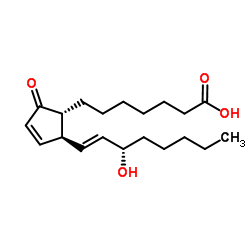PROSTAGLANDIN A1

PROSTAGLANDIN A1 structure
|
Common Name | PROSTAGLANDIN A1 | ||
|---|---|---|---|---|
| CAS Number | 14152-28-4 | Molecular Weight | 336.466 | |
| Density | 1.1±0.1 g/cm3 | Boiling Point | 510.7±50.0 °C at 760 mmHg | |
| Molecular Formula | C20H32O4 | Melting Point | 41 - 43ºC | |
| MSDS | Chinese USA | Flash Point | 276.7±26.6 °C | |
|
The cyclopentenone prostaglandin 15d-PGJ2 inhibits the NLRP1 and NLRP3 inflammasomes.
J. Immunol. 194(6) , 2776-85, (2015) Inflammasomes are cytosolic protein complexes that respond to diverse danger signals by activating caspase-1. The sensor components of the inflammasome, often proteins of the nucleotide-binding oligomerization domain-like receptor (NLR) family, detect stress,... |
|
|
Protective effects of n-6 fatty acids-enriched diet on intestinal ischaemia/reperfusion injury involve lipoxin A4 and its receptor.
Br. J. Pharmacol. 172(3) , 910-23, (2015) Long-term intake of dietary fatty acids is known to predispose to chronic inflammation, but their effects on acute intestinal ischaemia/reperfusion (I/R) injury is unknown. The aim of this study was to determine the consequences of a diet rich in n-3 or n-6 p... |
|
|
Vimentin filament organization and stress sensing depend on its single cysteine residue and zinc binding.
Nat. Commun. 6 , 7287, (2015) The vimentin filament network plays a key role in cell architecture and signalling, as well as in epithelial-mesenchymal transition. Vimentin C328 is targeted by various oxidative modifications, but its role in vimentin organization is not known. Here we show... |
|
|
Transient receptor potential ankyrin 1 (TRPA1) channel as emerging target for novel analgesics and anti-inflammatory agents.
J. Med. Chem. 53 , 5085-107, (2010)
|
|
|
TGA transcription factors and jasmonate-independent COI1 signalling regulate specific plant responses to reactive oxylipins.
J. Exp. Bot. 64(4) , 963-75, (2013) Jasmonates and phytoprostanes are oxylipins that regulate stress responses and diverse physiological and developmental processes. 12-Oxo-phytodienoic acid (OPDA) and phytoprostanes are structurally related electrophilic cyclopentenones, which activate similar... |
|
|
Greater stress protein expression enhanced by combined prostaglandin A1 and lithium in a rat model of focal ischemia.
Acta Pharmacol. Sin. 28(8) , 1097-104, (2007) To investigate the effects of lithium (Li) and prostaglandin A1 (PGA1) on the expression of heat shock factor 1 (HSF-1), heat shock proteins (HSP), and apoptosis protease activating factor-1 (Apaf-1) induced by permanent focal ischemia in rats.The rats were p... |
|
|
Enhancement of axonal regeneration by in vitro conditioning and its inhibition by cyclopentenone prostaglandins.
J. Cell Sci. 121(Pt 15) , 2565-77, (2008) Axonal regeneration is enhanced by the prior ;conditioning' of peripheral nerve lesions. Here we show that Xenopus dorsal root ganglia (DRG) with attached peripheral nerves (PN-DRG) can be conditioned in vitro, thereafter showing enhanced neurotrophin-induced... |
|
|
A radioimmunoassay for prostaglandin A1 in human peripheral blood.
J. Clin. Endocrinol. Metab. 41(2) , 245-52, (1975) A specific, sensitive and accurate radioimmunoassay (RIA) method for the measurement of prostaglandin A1 (PGA1) in either human whole blood or plasma is described. Whole blood is immediately lysed with distilled water containing tritiated indicator. When plas... |
|
|
Upregulation of MIP-2 (CXCL2) expression by 15-deoxy-Delta(12,14)-prostaglandin J(2) in mouse peritoneal macrophages.
Immunol. Cell Biol. 85(1) , 60-7, (2007) A peroxisome proliferator-activated receptor gamma (PPARgamma) ligand, 15-deoxy-Delta(12,14)-prostaglandin J(2) (15d-PGJ(2)), has been reported to possess anti-inflammatory activity in activated monocytes/macrophages. In this study, we investigated the effect... |
|
|
Effect of epidermal growth factor and prostaglandin on the expression of aromatase (CYP19) in human adrenocortical carcinoma cell line NCI-H295R cells.
J. Endocrinol. 188(1) , 59-68, (2006) We investigated the effects of epidermal growth factor (EGF) and prostaglandins (PG) on the expression of aromatase (CYP19) in human adrenocortical carcinoma cell line NCI-H295R cells. EGF significantly increased aromatase activity and CYP19 gene transcript i... |